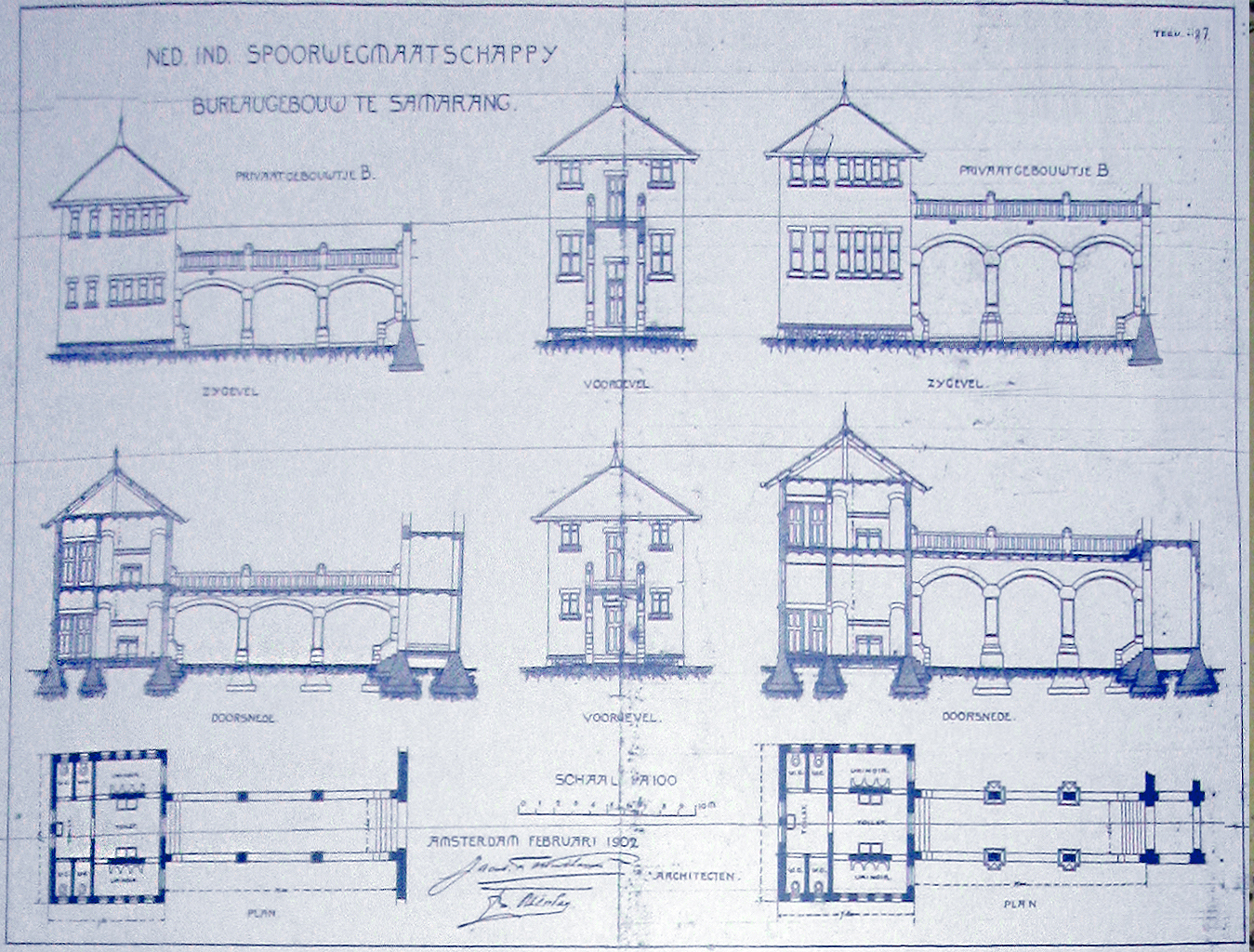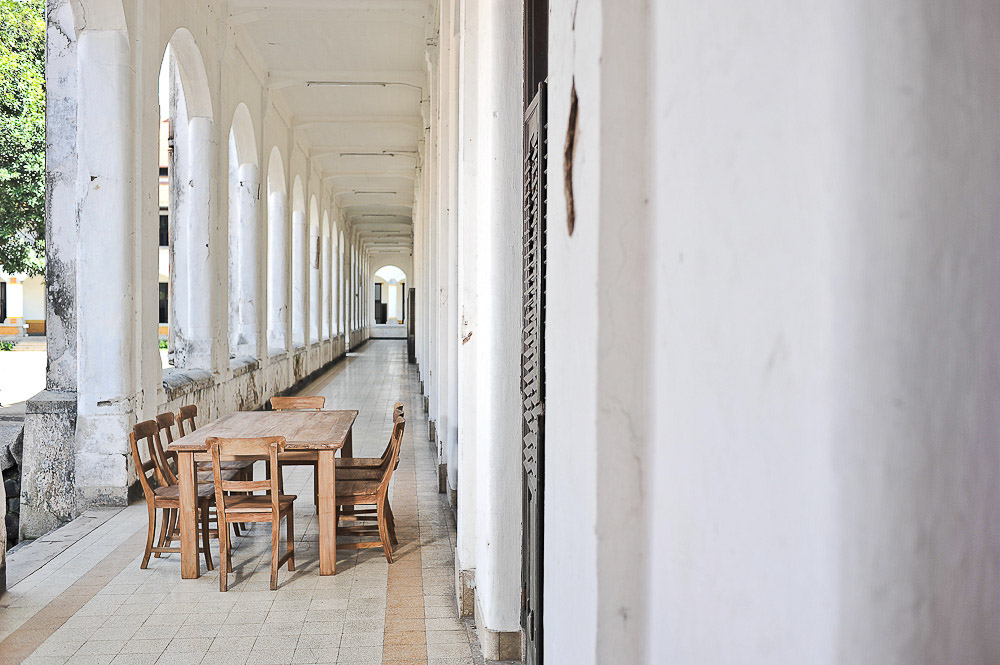Lawang Sewu on:
[Wikipedia]
[Google]
[Amazon]
''Lawang Sewu'' () is a former office building in
 The complex consists of several buildings, two main ones named A and B and two smaller ones named C and D, on Pemuda Street. The L-shaped A building faces the Tugu Muda roundabout. There are two identical towers on A building, which were originally used to store water, each with a capacity of . The building features large
The complex consists of several buildings, two main ones named A and B and two smaller ones named C and D, on Pemuda Street. The L-shaped A building faces the Tugu Muda roundabout. There are two identical towers on A building, which were originally used to store water, each with a capacity of . The building features large

 Lawang Sewu was designed by
Lawang Sewu was designed by
 According to
According to
Semarang
Semarang ( jv, ꦏꦸꦛꦯꦼꦩꦫꦁ , Pegon: سماراڠ) is the capital and largest city of Central Java province in Indonesia. It was a major port during the Dutch colonial era, and is still an important regional center and port today ...
, Central Java
Central Java ( id, Jawa Tengah) is a province of Indonesia, located in the middle of the island of Java. Its administrative capital is Semarang. It is bordered by West Java in the west, the Indian Ocean and the Special Region of Yogyakart ...
, Indonesia. It was a head office of the Dutch East Indies Railway Co. (Nederlandsch-Indische Spoorweg Maatschappij
The ''Nederlandsch-Indische Spoorweg Maatschappij'' (Dutch East Indies Railway Company), abbreviated NIS, was the railway company in charge of rail transport in Java, Dutch East Indies. The company's headquarters were in Semarang. The railway ...
/NIS) and is owned by the national railway company Kereta Api Indonesia
PT Kereta Api Indonesia (Persero) (English: Indonesian Railways Company, abbreviated as PT KAI or simply KAI) is the sole operator of public railways in Indonesia. It is completely state-owned and pays track access charges to the government. ...
(KAI). Its predecessor, Djawatan Kereta Api, was seized every rail transport infrastructures and offices from Dutch occupation. Today the building is used as a museum and heritage railway gallery, currently operated by Heritage Unit of KAI and its subsidiary KAI Wisata.
Etymology
The Javanese word ''lawang sewu'' is a nickname for the building, which means "a thousand doors". The name comes from its design, with numerous doors and arcs. The building has about 600 large windows.Layout
 The complex consists of several buildings, two main ones named A and B and two smaller ones named C and D, on Pemuda Street. The L-shaped A building faces the Tugu Muda roundabout. There are two identical towers on A building, which were originally used to store water, each with a capacity of . The building features large
The complex consists of several buildings, two main ones named A and B and two smaller ones named C and D, on Pemuda Street. The L-shaped A building faces the Tugu Muda roundabout. There are two identical towers on A building, which were originally used to store water, each with a capacity of . The building features large stained-glass windows
Stained glass is coloured glass as a material or works created from it. Throughout its thousand-year history, the term has been applied almost exclusively to the windows of churches and other significant religious buildings. Although tradition ...
and a grand staircase in the center. There was also once a tunnel connecting A building to several other sites in the city, including the governor's mansion and the harbour.
The B building is located behind A building. It is three stories in height, with the first two floors consisting of offices and the third holding a ballroom. The building, with high, large windows, also has a basement floor that is kept partially flooded to serve to cool the building through evaporation.
In front of A building stands a monument to five employees killed during the Indonesian National Revolution
The Indonesian National Revolution, or the Indonesian War of Independence, was an armed conflict and diplomatic struggle between the Republic of Indonesia and the Dutch Empire and an internal social revolution during postwar and postcol ...
.
History

 Lawang Sewu was designed by
Lawang Sewu was designed by Cosman Citroen
Cosman Citroen (26 August 1881 – 15 May 1935) was a Dutch architect. He designed buildings in the Dutch East Indies including the headquarters of the Dutch East Indies Railway Company.
Early life
Citroen was the son of Levie Citroen (born on N ...
, from the firm of J.F. Klinkhamer and B.J. Quendag. It was designed in New Indies Style, an academically-accepted term for Dutch Rationalism in the Indies. Similar with Dutch Rationalism, the style is the result of the attempt to develop new solutions to integrate traditional precedents (classicism) with new technological possibilities. It can be described as a transitional style between Traditionalists and the Modernists, and was strongly influenced by the design of Berlage.
The first Construction began in 1904 with A building, which was completed in 1907. The rest of the complex was finished in 1919. It was initially used by the Nederlandsch-Indische Spoorweg Maatschappij
The ''Nederlandsch-Indische Spoorweg Maatschappij'' (Dutch East Indies Railway Company), abbreviated NIS, was the railway company in charge of rail transport in Java, Dutch East Indies. The company's headquarters were in Semarang. The railway ...
, the first railway company in the Dutch East Indies
The Dutch East Indies, also known as the Netherlands East Indies ( nl, Nederlands(ch)-Indië; ), was a Dutch colony consisting of what is now Indonesia. It was formed from the nationalised trading posts of the Dutch East India Company, whic ...
.
After the Japanese Japanese invaded Indonesia 1942, the Japanese army took over Lawang Sewu.The basement of building B was turned into a dungeon, with torture and execution taking place there. When Semarang was retaken by the Dutch in the battle; in October 1945, the Dutch forces used the tunnel leading into A building to sneak into the city. A battle ensued, with numerous Indonesian fighters dying. Five employees working there were also killed.
After the war, the Indonesian army
The Indonesian Army ( id, Tentara Nasional Indonesia Angkatan Darat (TNI-AD), ) is the land branch of the Indonesian National Armed Forces. It has an estimated strength of 300,000 active personnel. The history of the Indonesian Army has its ...
took over the complex. It was later returned to the national railway company. In 1992, it was declared a Cultural Property of Indonesia.
By 2009, the Lawang Sewu complex was in a state of considerable dilapidation. Simon Marcus Gower, writing in ''The Jakarta Post
''The Jakarta Post'' is a daily English-language newspaper in Indonesia. The paper is owned by PT Niskala Media Tenggara and based in the nation's capital, Jakarta.
''The Jakarta Post'' started as a collaboration between four Indonesian med ...
'', noted it as being "dark and evidently sick. Its white walls are faded throughout; blackened by pollution and neglect. Rendered walls are cracked and any wall paper has long since fallen away to reveal the red bricks beneath. Mould and weeds grow over much of the building and mice and rats are the chief residents."
The building soon underwent renovations to ensure that it would be profitable as a tourist attraction. Governor of Central Java Bibit Waluyo
Bibit Waluyo (born 5 August 1949) is an Indonesian politician and lieutenant general, who served as the governor of Central Java from 2008 until 2013, when he was defeated by Ganjar Pranowo. Prior to entering politics, he was an officer in the I ...
mobilized several dozen soldiers to assist with the renovations; the soldiers focused on external repairs. Local residents were disappointed in the renovations, opining that it had lost its authenticity.
On 5 July 2011, the newly renovated complex was inaugurated by First Lady Ani Yudhoyono
Kristiani Herrawati Yudhoyono (6 July 1952 – 1 June 2019), more commonly known as Ani Yudhoyono, was an Indonesian political scientist, who was the wife of former Indonesian President Susilo Bambang Yudhoyono and First Lady of Indonesia from ...
. However, at the time, only B building was available for tours. It is hoped to be a main attraction in the Central Javan government's tourism program in 2013.
Future plans include transforming Building B into office space, a food court, and even a gym. In late 2013, the Semarang city government announced plans to eliminate the building's "spooky image" in order to attract more visitors. This was to encompass a reimagining of the site as a place for social and cultural activities, supported by renovations of the building. At the time, Lawang Sewu attracted an average of 1,000 visitors daily.
Haunting legend
urban legend
An urban legend (sometimes contemporary legend, modern legend, urban myth, or urban tale) is a genre of folklore comprising stories or fallacious claims circulated as true, especially as having happened to a "friend of a friend" or a family m ...
, the building is claimed to be haunted. According to Michael G. Vann, "decades of neglect" resulted in the abandoned building becoming subject to rumors, and "Ghost stories multiplied as Lawang Sewu truly began to look the part of a haunted house". These local ghost stories were "cemented into the national consciousness" with the 2007 horror film Lawang Sewu: Dendam Kuntilanak'' (''Lawang Sewu: Kuntilanak Vengeance'').
References
;Footnotes ;Bibliography * * * * * * * * * *External links
{{coord, 6, 59, 2.13, S, 110, 24, 38.28, E, type:landmark_dim:200, display=title Landmarks in Indonesia Reportedly haunted locations in Indonesia Buildings and structures by Dutch architects Buildings and structures in Semarang